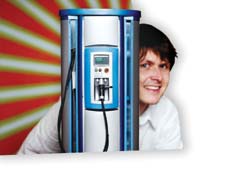Putting a face on hydrogen
Scandinavian-designed hydrogen filling stations will soon be in use in Iceland. The pump is designed to tell consumers they’re purchasing an environmentally friendly product.
The small island country of Iceland wants to be the first hydrogen society in the world, a place where non-polluting renewable energy fuels everything from cars to homes to industry. An ambitious goal perhaps – but earlier this year, the country’s first public hydrogen filling station opened outside the capital city of Reykjavik. The city is one of ten in Europe that has pledged to build hydrogen filling stations to refuel 30 hydrogen-powered buses. Sweden opened its first hydrogen filling station in Malmø in September.
Norway hasn’t yet endorsed a plan to install hydrogen filling stations, but that hasn’t stopped Norwegian designers, researchers and companies from getting involved in the new technology. Norsk Hydro has delivered several hydrogen fuel pumps to the European market. And a recent NTNU civil engineering graduate has come up with a design for a hydrogen filling station pump that will be installed at the Reykjavik facility at the end of 2003.
Neither loud nor gaudy
Lars-Fredrik Forberg wrote his dissertation at NTNU about creating new product designs for hydrogen fuel. His goal was to design a filling station pump that differed radically from the conventional petrol filling station design, because the new fuel is so different from petrol.
Forberg is among the first to write a thesis envisioning a design future for hydrogen products. The central question for his research was to examine the design values and messages that hydrogen products and fuel stations should send.
“Hydrogen dispensers should not communicate the same values as today’s petrol stations with loud neon lights, gaudy colours and the smell of petrol”, Forberg says. “They should communicate environmentally friendly values and purity by using clean materials and colours.”
A break with traditional design
The traditional petrol pump is made with steel plate construction in a tight, functionalist template. The few natural gas and hydrogen dispensers that do exist are often strongly influenced by this approach. Not Forberg’s. The NTNU designer chose an elliptical shape for the main part of the pump, with the curve of the ellipse reflected in the pump’s horizontal front.
The design is based on a value analysis that reflects the positive aspects of hydrogen technology.
“The exhaust from hydrogen-powered vehicles consists only of water. At the same time, water is the raw material in hydrogen production”, Forberg said. “That makes it natural to include water as a part of the dispenser’s design”.
With its blue colour, large clean surface and crystalline glass front, the pump reflects the purity and naturalness of water. Four parts of the pump are covered with a layer of etched blue glass. The glass is partly transparent, exposing some of the advanced technology on the inside of the pump. In the dark, light will shine through the dispenser from the back.

Here’s a view of what a filling station in Island could look like when the new hydrogen fuel pump is installed.
Photo: Pål Kittelsen
Quiet and safe
One thing drivers of hydrogen-powered vehicles notice immediately is the lack of noise. Hydrogen-powered cars and buses are driven by fuel cells and electromotors that are far more quiet than the old diesel-powered vehicles. By design, refuelling is equally silent, Forberg said, as a way to prolong the aesthetics of the experience.
One of the major challenges for Forberg has been to convey the idea that hydrogen products are safe. Most people believe that hydrogen is highly explosive and dangerous. So how can the message of safety be communicated through design? Forberg says the answer comes from having uniform, integrated design throughout the filling station. All the filling station components must be user-friendly, clean, safe and reliable – from the electrolyser, where the hydrogen is produced, to the dispenser. That conformity sends the message to consumers this new technology has been well thought out and is safe.
Designer and engineer
Forberg’s contribution has primarily been in the design of the outer fuel pump housing and the user interface. But because he’s both a designer and an engineer, he has also constructed the framework and prepared the filling station pump for production. Since completing his dissertation, Forberg has continued to work on the design details and has sent drafts off for production. The fuel pump is being is built at Norsk Hydro’s research centre workshop in Porsgrunn, with some of the parts outsourced to other companies.
The product development process itself began by mapping out the competition and the existing technology. Next, a 3-D computer design and construction program was used. Forberg’s completed drafts were fed directly into stamping and laser cutting machines where the steel plates for the fuel pumps were cut. User-friendliness and function have been critical parts of the design process, so that creating the pump also included designing a layout of the user interface, including the pump’s fuel nozzle, display panel and control buttons.
Gas under pressure
The hydrogen filling pumps operate just like ordinary petrol pumps, but the hydrogen is stored under high pressure, so that all the components must be sturdy and heavy. Forberg’s design is also ergonomic, and takes user safety into account.
During his work with the pump’s exterior details, Forberg also worked on the design of the interior components, using 3-D computer programs to visualize the arrangement and display of the valves, pressure indicators and other futuristic gizmos that drive the pump.
Forberg’s pump will first be installed in the Reyjavik filling station. He hopes the success of his design will inspire other Norwegian designers and manufacturers to get involved with the new technology. But most of all, Forberg hopes his clean, friendly, elliptical blue glass-fronted pump will be the model of choice when Norway finally opens its first public hydrogen filling station.
Text: Tore Hugubakken





